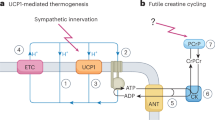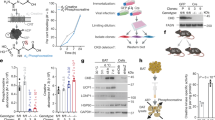Abstract
The mitochondrial uncoupling protein (UCP) in the mitochondrial inner membrane of mammalian brown adipose tissue generates heat by uncoupling oxidative phosphorylation1. This process protects against cold2 and regulates energy balance3. Manipulation of thermogenesis could be an effective strategy against obesity4–9. Here we determine the role of UCP in the regulation of body mass by targeted inactivation of the gene encoding it. We find that UCP-deficient mice consume less oxygen after treatment with a β3-adrenergic-receptor agonist and that they are sensitive to cold, indicating that their thermo-regulation is defective. However, this deficiency caused neither hyperphagia nor obesity in mice fed on either a standard or a high-fat diet. We propose that the loss of UCP may be compensated by UCP2, a newly discovered homologue of UCP; this gene is ubiquitously expressed and is induced in the brown fat of UCP-deficient mice.
This is a preview of subscription content, access via your institution
Access options
Subscribe to this journal
Receive 51 print issues and online access
$199.00 per year
only $3.90 per issue
Buy this article
- Purchase on Springer Link
- Instant access to full article PDF
Prices may be subject to local taxes which are calculated during checkout
Similar content being viewed by others
References
Nicholls, D. G. & Locke, R. M. Thermogenic mechanisms in brown fat. Physiol. Rev. 64, 1–64 (1984).
Foster, D. O. & Frydman, M. L. Tissue distribution of cold-induced thermogenesis in conscious warm- or cold-acclimated rats reevaluated from changes in tissue blood flow: the dominant role of brown adipose tissue in the replacement of shivering by nonshivering thermogenesis. Can. J. Physiol. Pharmacol. 57, 257–270 (1979).
Rothwell, N. J. & Stock, M. J. A role for brown adipose tissue in diet-induced thermogenesis. Nature 281, 31–35 (1979).
Champigny, O. et al. B3-Adrenergic receptor stimualtion restores message and expression of brown-fat mitochondrial uncoupling protein in adult dogs. Proc. Natl Acad. Sci. USA 88, 10774–10777 (1991).
Himms-Hagen, J. et al. Effect of CL-316,243, a thermogenic B3-agonist, on energy balance and brown and white adipose tissues in rat. Am. J. Physiol. 266, R1371–R1382 (1994).
Kozak, L. P., Kozak, U. C. & Clarke, G. T. Abnormal brown and white fat development in transgenic mice overexpressing glycerol 3-phosphate dehydrogenase. Genes Dev. 5, 2256–2264 (1991).
Lowell, B. B. et al. Development of obesity in transgenic mice after genetic ablation of brown adipose tissue. Nature 366, 740–742 (1993).
Kopecky, J., Clarke, G., Enerback, S., Spiegelman, B. & Kozak, L. P. Expression of the mitochondrial uncoupling protein gene from the aP2 promoter prevents genetic obesity. J. Clin. Invest. 96, 2914–2923 (1995).
Cummings, D. E. et al. Genetically lean mice result from targeted disruption of protein kinase A. Nature 382, 622–626 (1996).
Thomas, K. R. & Capecchi, M. R. Site-directed mutagenesis by gene targeting in mouse embryoderived stem cells. Cell 51, 503–512 (1987).
Gossler, A., Doestchman, T. C., Korn, R., Serfling, E. & Kemler, R. Transgenesis by means of blastocystderived embryonic stem cell lines. Proc. Natl Acad. Sci. USA 83, 9065–9069 (1986).
Kozak, L. P., Britton, J. H., Kozak, U. C. & Wells, J. M. The mitochondrial uncoupling protein gene. Correlation of exon structure to transmembrane domains. J. Biol. Chem. 263, 12274–12277 (1988).
Cannon, B. & Vogel, G. The mitochondrial ATPase of brown adipose tissue. Purification and comparison with mitochondria ATPase from beef heart. FEBS Lett. 76, 284–289 (1977).
Susulic, V. S. et al. Targeted disruption of the β3-adrenergic receptor gene. J. Biol. Chem 270, 29483–29492 (1995).
Holloway, B. R. et al. ICI D7114 a novel selective β-adrenoceptor agonist selectively stimulates brown fat and increases whole body oxygen consumption. Br. J. Pharmacol. 104, 97–104 (1991).
Hamann, A., Flier, J. S. & Lowell, B. B. Decreased brown fat markedly enhances susceptibility to dietinduced obesity, diabetes and hyperlipidemia . Endocrinology 137, 21–29 (1996).
Billington, C. J., Briggs, J. E., Grace, M. & Levine, A. S. Effects of intracerebroventricular injection of neuropeptide Y on energy metabolism. Am. J. Physiol. 266, R1765–R1770 (1991).
Koza, R. A. et al. Sequence and tissue-dependent RNA expression of mouse FAD-linked glycerol-3-phosphate dehydrogenase. Arch. Biochem. Biophys. 336, 97–104 (1996).
Melnyk, A., Harper, M.-E. & Himms-Hagen, J. Raising at thermoneutrality prevents obesity and hyperphagia in brown adipose tissue-ablated transgenic mice. Am. J. Physiol. 272, R1088–R1093 (1997).
Leibel, R. L., Rosenbaum, M. & Hirsch, J. Changes in energy expenditure resulting from altered body weight. N. Engl. J. Med. 332, 621–628 (1995).
Lean, M. E. J. & James, W. P. T. in Brown Adipose Tissue (eds Trayhurn, P. & Nicholls, D. G.) 339–365 (Arnold, London, 1986).
Soriano, P., Montgomery, C., Geske, R. & Bradley, A. Targeted disruption of the c-src proto-oncogene leads to osteopetrosis in mice. Cell 64, 693– 702 (1991).
Chomczynski, P. & Sacchi, N. Single-step method of RNA isolation by acid guanidium thiocyanatephenol-chloroform extraction. Analyt. Biochem. 162, 156–159 (1987).
Derman, E. et al. Transcriptional control in the production of liver-specific mRNAs. Cell 23, 731–739 (1981).
Feinberg, A. P. & Vogelstein, B. A technique for radiolabelling DNA restriction endonuclease fragments to high specific activity. Analyt. Biochem. 132, 6–13 (1983).
Zeviani, M. et al. Sequence of cDNAs encoding subunit Vb of human and bovine cytochrome c oxidase. Gene 65, 1–11 (1988).
Bernlohr, D. A., Angus, C. W., Lane, M. D., Bolanowski, M. A. & Kelly, T. J. J. Expression of specific mRNAs during adipose differentiation: identification of an mRNA encoding a homologue of myelin P2 protein. Proc. Natl Acad. Sci. USA 81, 5468–5472 (1984).
Kozak, L. P. & Birkenmeier, E. H. Mouse sn-glycerol-3-phosphate dehydrogenase: molecular cloning and genetic mapping of a cDNA sequence. Proc. Natl Sci. USA 80, 3020–3024 (1983).
Kyte, J. & Doolittle, R. F. A simple method for displaying the hydropathic character of a protein. J. Mol. Biol. 157, 105–132 (1982).
Ma, S. W. & Foster, D. O. Starvation-induced changes in metabolic rate, blood flow, and regional energy expenditure in rats. Can. J. Physiol. Pharmacol. 64, 1252–1258 (1986).
Thomas, S. A. & Palmiter, R. D. Thermoregulatory and metabolic phenotypes of mice lacking noradrenaline and adrenaline Nature 387, 94–97 (1997).
Author information
Authors and Affiliations
Rights and permissions
About this article
Cite this article
Enerbäck, S., Jacobsson, A., Simpson, E. et al. Mice lacking mitochondrial uncoupling protein are cold-sensitive but not obese. Nature 387, 90–94 (1997). https://doi.org/10.1038/387090a0
Received:
Accepted:
Issue Date:
DOI: https://doi.org/10.1038/387090a0
This article is cited by
-
Long-term effects of a fat-directed FGF21 gene therapy in aged female mice
Gene Therapy (2024)
-
UCP1 alleviates renal interstitial fibrosis progression through oxidative stress pathway mediated by SIRT3 protein stability
Journal of Translational Medicine (2023)
-
A critical assessment of the role of creatine in brown adipose tissue thermogenesis
Nature Metabolism (2023)
-
Sensing the oxygen and temperature in the adipose tissues – who’s sensing what?
Experimental & Molecular Medicine (2023)
-
A subpopulation of lipogenic brown adipocytes drives thermogenic memory
Nature Metabolism (2023)
Comments
By submitting a comment you agree to abide by our Terms and Community Guidelines. If you find something abusive or that does not comply with our terms or guidelines please flag it as inappropriate.



